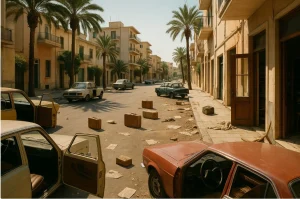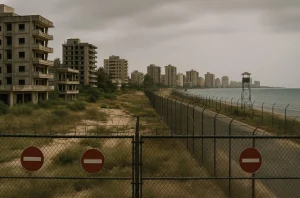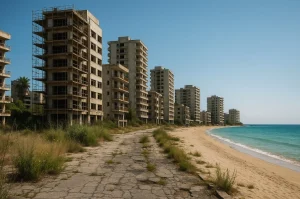What Led to the Rise of Famagusta and Its Tourist Boom?
In the early 1970s, Famagusta particularly its Varosha district was the crown jewel of Cyprus’s tourism industry. This bustling beachside resort was known for its high-end hotels, sunny shores, and vibrant nightlife.
It attracted celebrities, wealthy tourists, and international investors, making it one of the most sought-after destinations in the Mediterranean.
Before its sudden downfall, Varosha was compared to places like Nice on the French Riviera or Miami Beach, hosting stars like Elizabeth Taylor and Brigitte Bardot. The area was a symbol of modernity, prosperity, and multicultural coexistence.
Why Did the Greek Cypriot Population Flee Famagusta in 1974?

The abandonment of Famagusta occurred amidst the chaos of the 1974 Cyprus conflict, a defining moment in the island’s history. In July 1974, a military coup backed by the Greek junta sought to unite Cyprus with Greece.
This political manoeuvre sparked a swift and forceful response from Turkey, which launched a military intervention, citing its role as a guarantor under the Treaty of Guarantee.
As Turkish troops advanced, tens of thousands of Greek Cypriots fled their homes, fearing violence. The residents of Varosha, despite being far from the front lines initially, evacuated en masse, expecting to return within days.
They left behind fully furnished homes, running businesses, and personal belongings some even left food on the table. To this day, most of those displaced have never returned.
Why Was Varosha Sealed Off and Placed Under Military Control?
After the exodus, the Turkish military took control of Varosha and swiftly fenced off the entire district, declaring it a military zone.
This created a sealed-off area where no civilians, Greek or Turkish Cypriot, were allowed to enter. Access was strictly prohibited, and the once-busy resort town became a no-go zone, left to decay.
For decades, Varosha remained untouched nature reclaimed buildings, trees grew through walls, and cars rusted in place. The city became frozen in time, a decaying reminder of a once-thriving paradise.
How Did Varosha Become a Symbol of the Cyprus Conflict?

Famagusta’s abandonment wasn’t just a local tragedy it became an international symbol of the unresolved Cyprus Problem.
The division of the island between the Republic of Cyprus (south) and the Turkish Republic of Northern Cyprus (north) (recognised only by Turkey) left thousands of displaced Greek Cypriots without access to their properties.
Varosha evolved into a political bargaining chip, heavily militarised and used as leverage in countless rounds of failed peace talks.
Despite UN Resolution 550, which called for the area to be handed over to its rightful inhabitants under UN administration, no agreement was reached.
The city became a physical manifestation of diplomatic deadlock, a ghost town where no one could live, invest, or rebuild.
What Is the Current Status of Varosha Today?
In a controversial and politically charged move, parts of Varosha were reopened to the public in October 2020 by Turkish and Turkish Cypriot authorities. For the first time in 46 years, visitors mostly Turkish nationals and tourists were allowed to walk the streets of the abandoned city.
However, the Republic of Cyprus, along with international organisations including the United Nations and the European Union, condemned the move. They argued that the reopening violated existing UN resolutions and property rights of displaced Greek Cypriots.
Despite this partial reopening:
- Most buildings remain inaccessible
- Ownership disputes are unresolved
- The military presence remains
The reopening has deepened tensions rather than eased them.
Why Hasn’t Famagusta Been Rebuilt or Reclaimed?

The primary reasons Famagusta remains abandoned include:
- Legal complexity: Properties still legally belong to Greek Cypriots, and international law supports their claims.
- Political stalemate: Rebuilding efforts are tied to broader peace negotiations that have repeatedly failed.
- Military control: The area is under Turkish army jurisdiction, restricting access and development.
- International pressure: Any unilateral development risks condemnation and sanctions.
Examples of stalled redevelopment include UN-backed reunification proposals like the Annan Plan in 2004, which failed after a majority of Greek Cypriots voted against it. Even with strong international backing, political will on both sides remains fractured.
Can Famagusta Ever Be Fully Restored?
Restoration of Famagusta is possible but only through a comprehensive political solution that addresses:
- Property restitution
- Military withdrawal
- Diplomatic recognition
- Rebuilding cooperation
In recent years, civil society groups, bi-communal initiatives, and international diplomats have all pushed for Famagusta to become a model of reconciliation and peace.
However, unless a lasting agreement is achieved between Greek and Turkish Cypriot leaders, backed by international consensus, the ghost town may remain in limbo.
Timeline: Key Events in the History of Famagusta
| Year | Event |
| 1974 | Turkish invasion of Cyprus; Famagusta evacuated |
| 1974 | Varosha sealed off by Turkish military |
| 1984 | UN Resolution 550 calls for return of Varosha to original inhabitants |
| 2004 | Cyprus joins EU; reunification plan rejected |
| 2020 | Partial reopening of Varosha by Turkish authorities |
| 2023 | Ongoing political tensions; no agreement on Varosha’s future |
FAQs About Why Famagusta Was Abandoned
Was the abandonment of Famagusta planned or sudden?
It was a sudden evacuation due to the Turkish military’s advance during the 1974 invasion. Residents fled expecting to return within days but were never allowed back.
Why is the reopening of Varosha controversial?
Because it violates UN resolutions and disregards the property rights of displaced Greek Cypriots. The Republic of Cyprus and international bodies see it as illegal.
Who lives in Varosha now?
No one. While parts of Varosha are open to visitors, it remains uninhabited and under military control.
Can former residents reclaim their homes or property?
Legally, many still hold deeds and ownership rights, but in practice, reclaiming property is extremely difficult without a political agreement.
Is Famagusta the only ghost town in Cyprus?
It’s the most well-known, but other villages, particularly near the buffer zone, were also abandoned due to the conflict.
What role does the UN play in the Famagusta situation?
The UN has called for the return of Varosha to its original inhabitants and continues to monitor the buffer zone, but has limited enforcement power.
Could Famagusta be turned into a peace-building project?
Yes, many advocate for turning it into a model of reunification and coexistence, but it would require significant cooperation and trust from both sides.






